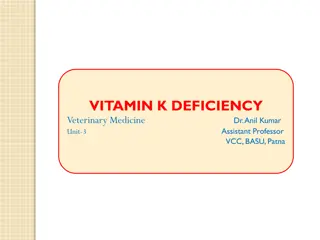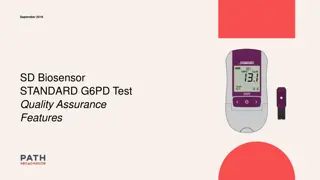Guideline Updates on Drug Safety in G6PD Deficiency
Ongoing work includes progress on CPIC guidelines for aminoglycosides, clopidogrel, and statins, along with evidence reviews for various enzymes and medications. A review of G6PD deficiency and rasburicase safety is being conducted, categorizing drugs as low-to-no risk, high-risk, or medium-risk based on available evidence. The term standardization is also a current focus.
Download Presentation

Please find below an Image/Link to download the presentation.
The content on the website is provided AS IS for your information and personal use only. It may not be sold, licensed, or shared on other websites without obtaining consent from the author.If you encounter any issues during the download, it is possible that the publisher has removed the file from their server.
You are allowed to download the files provided on this website for personal or commercial use, subject to the condition that they are used lawfully. All files are the property of their respective owners.
The content on the website is provided AS IS for your information and personal use only. It may not be sold, licensed, or shared on other websites without obtaining consent from the author.
E N D
Presentation Transcript
CPIC guideline in progress MT-RNR1/aminoglycosides-in review (just resubmitted revisions) CYP2C19/clopidogrel drafting guideline Statin guideline Draft recommendations for SLCO1B1 and ABCG2 Finalizing evidence review for HMGCR, CYP2C9, CYP3A SSRI/SNRI Evidence review ongoing for CYP2D6, CYP2C19, HTR2A, ABCB1, SLC6A4, and CYP2B6 CYP2D6/Beta-blockers Authorship plan approved by steering committee CYP2D6/antipsychotics Will begin this guideline when SSRI evidence review is complete
G6PD/rasburicase update Is the drug listed in Supplemental Table S6? YES NO Is there a warning regarding G6PD deficiency on the drug label by FDA or another regulatory agency? Is the drug deemed safe in G6PD deficiency by all the references in Table S6? YES NO YES NO Include Is the drug used in clinical practice today? Exclude Exclude YES NO Include Exclude
G6PD/rasburicase update Is the drug listed in Supplemental Table S6? YES NO Is there a warning regarding G6PD deficiency on the drug label by FDA or another regulatory agency? Is the drug deemed safe in G6PD deficiency by all the references in Table S6? YES NO YES NO Include Is the drug used in clinical practice today? Exclude Exclude YES NO Include Exclude
Assigning putative G6PD drugs to a risk category Low-to-no risk: no need for increased caution on basis of G6PD High-risk: avoid in G6PD deficiency Medium-risk: use caution High-level evidence, rarely used OR moderate level evidence, rarely used with regulatory warnings OR moderate level evidence with strong mechanism Weak evidence AND rarely used drug OR Weak evidence AND subject of strong regulatory warnings (that may have hindered drug s use in G6PD deficient pts) Weak evidence AND commonly used drug OR Weak evidence AND mild or inconsistent regulatory warnings
Term Standardization Part 2 5/6/2021
Term standardization Part 1 Drug Metabolizing Enzymes (CYP enzymes, DPYD, TPMT) Drug Transporters (SLCO1B1) High risk alleles (HLA)
Gene/Disease expert panel will review current terminologies* as part of the CPIC guideline development process and recommend terms for allele clinical function status and phenotype PGx expert panel will review and provide feedback to gene/disease expert panel for recommended terms Process will continue until 70% of experts agree to terms Terms will be posted for public comment Terms will be used in CPIC guideline CPIC informatics working group will work to submit to LOINC, SNOMED, others
Expert panels Gene/Guideline expert panel CPIC guideline authors Representation from other expert panels, if applicable (i.e. working group regarding the guideline topic) ClinGen Variant Curation Expert Panel ClinVar FDA ACMG Other gene/disease specific resources (e.g., G6PD WHO working group, European Malignant Hyperthermia Group, etc) Others as determined by guideline authors PGx expert panel Clinician with a working knowledge of pharmacogenetics (pharmacists, physicians, nurses, genetic counselors, etc). Researcher with at least 2 years of PGx research experience Clinical laboratory scientist or staff with at least 2 years of PGx experience EHR standards expert/medical informatic (PGx experience not required but involvement in HL7 or similar experience preferred)
Evaluation of current terminologies Gene/Disease expert panel will review all current terminology in the following resources: ClinGen ClinVar FDA ACMG LOINC SNOMED Other gene/disease specific resources Laboratory reports Guideline authors will utilize current terminology if/where appropriate. In some cases, disease terminology will not be appropriate if disease phenotype not 1:1 with drug phenotype (i.e. variants that are associated with disease risk are not all associated with drug phenotype and vice versa).
Experts-primary involvement in PGx Clinician with a working knowledge of pharmacogenetics (pharmacists, physicians, nurses, genetic counselors, etc). Researcher with at least 2 years of PGx research experience Clinical laboratory scientist or staff with at least 2 years of PGx experience EHR standards expert/medical informatics Gene specific experts and/or CPIC or DPWG guideline author for genes included in this project 59% 47% 24% 6% 18%
Genotypes Example genotypes Likely phenotype MT-RNR1 aminoglycoside-induced hearing loss increased risk Individuals with a MT-RNR1 variant associated with an increased risk of aminoglycoside-induced hearing loss 1095T>C 1494C>T 1555A>G MT-RNR1 aminoglycoside-induced hearing loss normal risk Individuals with no detectable MT-RNR1 variant or a variant associated with normal risk of aminoglycoside-induced hearing loss 827A>G MT-RNR1 aminoglycoside-induced hearing loss indeterminate risk Individuals with a MT-RNR1 variant associated with an uncertain risk of aminoglycoside-induced hearing loss 663A>G 669T>C 747A>G 786G>A 807A>G 807A>C 839A>G 896A>G 930A>G 951G>A 960C>del 961T>G 961T>del 961T>del+Cn 988G>A 1189T>C 1243T>C 1438A>G 1520T>C 1537C>T
Clinical function assignment term increased risk of aminoglycoside-induced hearing loss normal risk of aminoglycoside-induced hearing loss uncertain risk of aminoglycoside-induced hearing loss
n=39 We have consensus! Do you agree with the following term for MT-RNR1 allele function? 95% 100% 90% 80% 70% 60% 50% 40% 30% 20% 5% 10% 0% I agree I do not agree.
Phenotype terms MT-RNR1 aminoglycoside-induced hearing loss increased risk MT-RNR1 aminoglycoside-induced hearing loss normal risk MT-RNR1 aminoglycoside-induced hearing loss indeterminate risk [gene] [drug phenotype] [increased, normal, uncertain] risk OR [gene] [increased, normal, uncertain] risk of [drug phenotype]
n=34 Are the following terms used to describe MT-RNR1 phenotype acceptable? 100% 91% 90% 80% 70% 60% 50% 40% 30% 20% 9% 10% 0% Acceptable Not acceptable. Please explain why and suggest alternative wording.
Possible and likely phenotypes possible Known function allele (decrease, no function) plus an uncertain/unknown function variant
Feedback Prefer likely "Possible" is misleading as this is really saying that this phenotype is "likely." There are other phenotypes that are "possible. In practice, I have found "possible" modifiers to lead to significant confusion. Would recommend we avoid or go to the ACMG type term of "likely" Possible" provides very little helpful information--it opens up questions on what are the other possibilities. "Likely" provides a bit more certainty, when available and appropriate. Range of phenotypes I don't like the "possible" modifier much because it doesn't rule anything in or out. In this context, there are no increased function alleles, so we know that an individual with one no function allele is not a normal metabolizer. For this reason, I might suggest the term "poor or intermediate metabolizer" for a *2/*8, etc. Suggestion: "Possible intermediate-poor metabolizer Unless the uncertain variant has the possibility of having increased function, then I think that it would be clearer to use "poor-to-intermediate" or a similar term. I'm concerned that the use of "possible" will lead uninformed clinicians to think more along the lines of "normal-to-intermediate" rather than "intermediate- to-poor" function levels.
Feedback Other I think it could be useful to add a grade of certainty to your nomenclature. For example, in cardiology guidelines, we use I, IIa, IIb, III. If we translate this to genetic variants functionality or clinical validity, I and III would be clear cut variants with I being definite association; III definitely no association, while IIa would be uncertain, but likely has an impact; and IIb, uncertain, but lower likelihood. I don't like the modifier "possible" in this case. To me it indicates intermediate or higher activity when it should better indicate "no higher than intermediate activity". I know this is awkward but we can consider "at most intermediate metabolizer". I don't like "intermediate or poor metabolizer". hard to implement "possible IM" into decision support
Feedback Rationale to use possible I like the term possible for these scenarios. BPAs will fire for these patients and give guidance if it s clinically relevant so I m not worried of clinicians being confused about this terms meaning. I can see the benefits of it as it could make prescribing recommendations applicable to more patients. However, I would prefer for it to be used sparingly and only after a lot of consideration from the authors about the benefits v risk to patients with genotypes falling into this category
Possible and likely phenotypes likely Uncertainty of phenotype grouping (but know the phenotype is not normal).
Feedback Likely: 6 not sure, 7 do not like, 22 like Range of phenotypes suggested again here. I do not like this. It conveys a difference in probability from the other scenario that I don't think is real. OK with me but "probable" is another option if people don't like likely. It conveys a little more certainty than "likely" in my opinion. Expected I don t like the use of likely for this. I think that people would reasonably expect that if they had 2 patients, and one was a possible IM and the other was a likely IM, that the later would have a higher chance of being an IM than the former. In reality, we don t know that. I think that we should use words like possible when we are making our best guess at a phenotype (for whatever reason) and then use comments (multiple words) to explain why we are not sure. Otherwise we are adding to the already very high burden of pharmacogenomic-specific language that gets in the way of widespread implementation. Likely provides more confidence than "possible"--but should only be used when appropriate and accurate. It's not my favorite but I don't have a better way to put it.
Do we need separate terms? Not sure-7; NO-18, YES-12 YES should be separate terms I think they are represented correctly. Possible to me has less certainly than likely. Possible includes one variant with unknown function, thus fits well. Therefore, the functional level has not been determined yet at all. Likely, both variant's functions are known, but the exact functional level has not been determined yet. I think separate term make more sense to me as "potential for" (possible) is distinct from "probable" relative to likely. There should be separate terms then users have an idea where the uncertainty is coming from (either at the allele level or at the phenotype grouping level) and don't need to dig around themselves.
Do we need separate terms? NO should be the same term Good question. I dont know. This is sooo difficult. In the tables above for both 2C19 and TMPT/NUDT15, both modifiers can make sense. In essence, both modifiers really mean the same thing - it COULD be this type of phenotype. In the end, i guess its not so important which term is used; better is that the consequence (potenttal change of therapy) arising from the phenotype assignment is clear and warranted (supported by the clinical evidence). No. Use "possible" to convey the "worst case scenario" and then explain (using more words). If two terms truly allow specificity, then two terms are fine. However, it is not clear to me that the two separate term do provide specificity. I am a bit worried about creating all of these extra terms and then the authors (or the users of the guidelines) not understanding what they really mean I would prefer using "likely" in both situations, or not using modifiers at all. In the TPMT example, it is known that the patient has at least one no-function allele, so it is almost certain that they are not a normal metabolizer (I don't know if increased function vars have ever been reported for TPMT). The use of "possible intermediate", if I were reading this as a patient, would suggest to me that I'm normal and possibly intermediate, when I think it's supposed to be conveying that I'm at least intermediate, possibly poor metabolizer. I would favor just reporting this type of result as "intermediate metabolizer", without any modifiers, but maybe add a footnote that an unknown variant was also present? For a guideline table it may be reasonable to combine them if the wording is the same (noting that it is poor or likely poor for example). For the CDS resources they need to be separate b/c systems may need to align categories with genotypes. There should be separate terms then users have an idea where the uncertainty is coming from (either at the allele level or at the phenotype grouping level) and don't need to dig around themselves.
Likely Term is used by ACMG Because there is no quantitative definition of the term 'likely', the ACMG/AMP committee proposed that the terms 'likely pathogenic' and 'likely benign' be used to mean greater than 90% certainty of a variant either being disease causing or benign to provide laboratories with a common, albeit arbitrary, definition SNOMED
Possible SNOMED modifier term
Is the term "likely" acceptable to describe uncertainty of phenotype ? 90% 85% 80% 70% 60% 50% 40% 30% 20% 12% 10% 3% 0% Yes-the term is acceptable I do not know No. Please provide additional terms you would like the experts to consider.
Is the term "possible" acceptable to describe a known allele function plus an uncertain/unknown function? 60% 56% 50% 38% 40% 30% 20% 10% 6% 0% Yes-the term is acceptable I do not know No. Please provide additional terms you would like the experts to consider.
Discussion and next survey We will continue to discuss the modifier terms We will continue to engage ACMG, AMP, ClinGen, etc to establish terms acceptable to the genomics community.























